

Have you ever noticed that after heavy rain, your yard area becomes a soggy mess? Water collects in low-lying areas, making plant growth difficult and transforming your once-beautiful yard into a muddy bog. This is where properly installed drainage and erosion control systems come into consideration.
Installation of the drainage system in your yard is essential for various reasons. It is one of the most important functional factors of a landscape design. The drainage system ensures that excess water is efficiently removed, reducing waterlogging and preventing potential damage to plants, structures, and the entire landscape. Also, it helps in the prevention of soil erosion by diverting water away from vulnerable areas, protecting soil integrity, and avoiding sediment discharge. Furthermore, proper drainage decreases the chance of basement floods and foundation damage. These installations maintain the beauty of the yard, protect important topsoil, and durability of the landscape by reducing erosion.
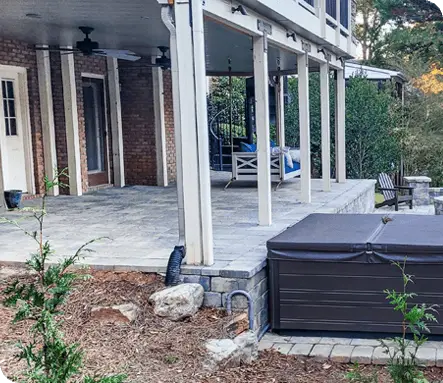

At Outdoor Makeover and Living Spaces, we are committed to offering you excellent Drainage & Erosion Control installation services in Atlanta. By understanding water flow, rain damage, soil damage, and water runoff, our team of landscape drainage professionals addresses these issues in the beginning stages and provides possible solutions. After finding the best possible way to effectively drain water from your lawn or hardscape surfaces, we ensure that your yard is converted into a well-drained, erosion-free environment with our rigorous approach and attention to detail. Trust us to achieve great outcomes while improving the health and appearance of your outdoor space.

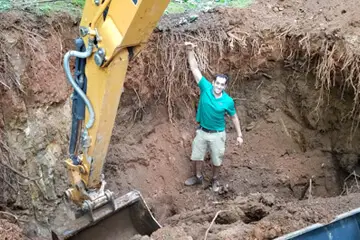
Man-made sinkholes can cause severe damage to a home or anything surrounding them. There are three different types of sinkholes: a development hole, a lot clearing hole, and a clean-up hole. A development hole occurs during the beginning stage of construction when debris is buried rather than disposed of properly. A lot clearing hole is more common and is usually created during the end of construction of the original foundation. A clean-up hole occurs when the remaining debris at the end of a project is buried.
Natural sinkholes are also common and occur when there is a collapsing bedrock of underground holes. On the surface, these holes can be cumbersome and seem to never be filled. We have unique solutions to solve the problem at its core. Each sinkhole is different and should be approached with caution. At Outdoor Makeover & Living Spaces, we are trained to properly fill a sinkhole with the right compacting materials. We use a few different approaches and can work within your budget.
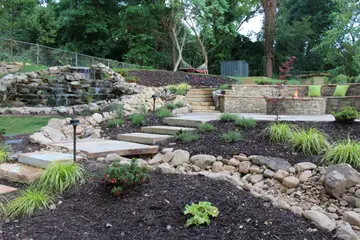
A natural-looking feature and effective drainage solution. This is a non-organic landscape design element and form of hardscaping t This is a great choice for a home to fix your drainage issues. It’s a gully or trench lined with stones and edged with plants to mimic natural riparian areas. Think of it like a water highway where water can flow without taking any soil or vegetation with it. The best place to install one is to intercept the water and reroute it to a different part of the home or install it where water wants to go already. This way, you may prevent erosion by reducing water runoff with the implementation of drainage stream beds.
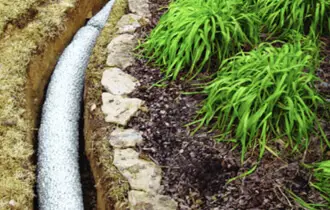
EZ Drain is a highly efficient French drainage system designed for residential and commercial applications. Its innovative design features a prefabricated geotextile-wrapped aggregate pipe that offers easy installation and excellent water absorption to dry up wet areas of the yard. With EZ Drain, maintaining a dry and functional environment has never been easier.
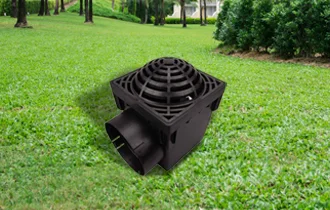
An atrium grate option is a modern and efficient solution for managing rainwater in urban areas. These types of drainage systems are designed to channel water and debris from the surface level area to the underground drainage systems. They can be typically installed at the ground level and are commonly found in patios, driveways,or in plant beds.
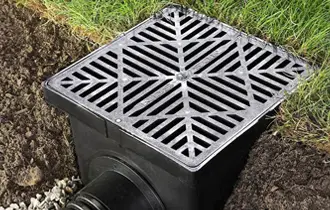
A structure beneath the ground that collects and holds surplus water or trash. It is an important piece of landscape project that is used to manage stormwater runoff.
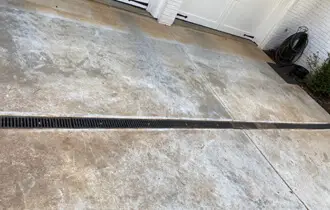
A Channel Drain system is a simple and effective way to manage excess water in outdoor areas. This linear drainage system is great for managing surface water. It has a streamlined, linear design that effectively catches and distributes water away from the structure, preventing pooling and potential damage. It’s perfect for driveways, patios, and other hardscaped areas.
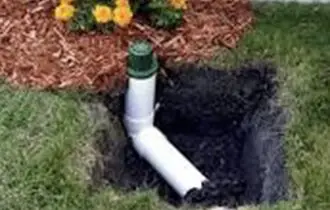
A system designed to collect excess water efficiently, preventing pooling and potential damage. In other words, this dry well drainage system is an eco-friendly alternative to catch basins where it creates a permeable area underground for excess water to percolate and get absorbed. It is usually placed in the low part of the property where water wants to go already.

A dry well is a way of managing excess water flow caused by heavy rain or other causes. It collects and disperses water into the ground, avoiding pooling or floods.
If you are searching for the best Backyard Makeover Company In Atlanta that stands by its reputation, Outdoor Makeover, and Living Spaces is always ready to provide you with the quality services you want. We are a diverse team led by highly trained engineers and incredible visionaries. Need help with Drainage & Erosion Control Installation? Get in touch with us today.

Make an appointment with our Outdoor Solution Designers today!
OR
Outdoor Makeover & Living Spaces is properly insured, has workman’s comp insurance, and holds a General Contractor’s license for decks, pools and roofs.
LET'S BE SOCIAL: